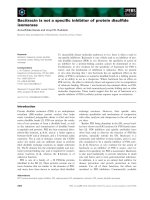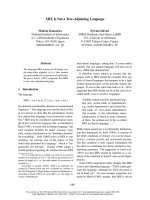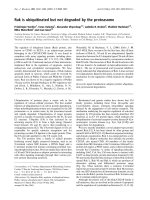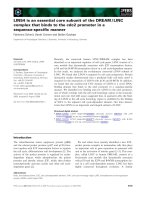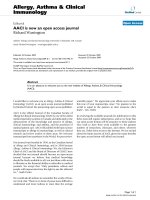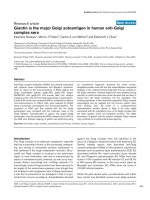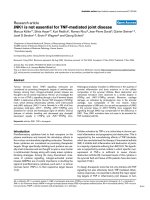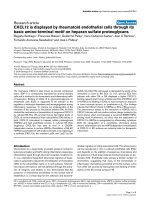Báo cáo y học: "JNK1 is not essential for TNF-mediated joint disease" doc
Bạn đang xem bản rút gọn của tài liệu. Xem và tải ngay bản đầy đủ của tài liệu tại đây (960.85 KB, 8 trang )
Open Access
Available online />R166
Vol 7 No 1
Research article
JNK1 is not essential for TNF-mediated joint disease
Marcus Köller
1
*, Silvia Hayer
2
*, Kurt Redlich
1
, Romeo Ricci
3
, Jean-Pierre David
3
, Günter Steiner
1,2
,
Josef S Smolen
1,2
, Erwin F Wagner
3
and Georg Schett
1
1
Department of Internal Medicine III, Division of Rheumatology, Medical University of Vienna, Austria
2
CeMM, Center of Molecular Medicine of the Austrian Academy of Sciences, Vienna, Austria
3
Research Institute of Molecular Pathology, Vienna, Austria
* Contributed equally
Corresponding author: Georg Schett,
Received: 4 Aug 2004 Revisions requested: 26 Aug 2004 Revisions received: 14 Oct 2004 Accepted: 10 Nov 2004 Published: 7 Dec 2004
Arthritis Res Ther 2005, 7:R166-R173 (DOI 10.1186/ar1473)
http://arthr itis-research.com/conte nt/7/1/R166
© 2004 Köller et al.; licensee BioMed Central Ltd.
This is an Open Access article distributed under the terms of the Creative Commons Attribution License ( />2.0), which permits unrestricted use, distribution, and reproduction in any medium, provided the original work is cited.
Abstract
Tumour necrosis factor (TNF) signalling molecules are
considered as promising therapeutic targets of antirheumatic
therapy. Among them, mitogen-activated protein kinases are
thought to be of central importance. Herein, we investigate the
role in vivo of TNF-α signalling through c-Jun N-terminal kinase
(JNK)1 in destructive arthritis. Human TNF transgenic (hTNFtg)
mice, which develop inflammatory arthritis, were intercrossed
with JNK1-deficient (JNK1
-/-
) mice. Animals (n = 35) of all four
genotypes (wild-type, JNK1
-/-
, hTNFtg, JNK1
-/-
hTNFtg) were
assessed for clinical and histological signs of arthritis. Clinical
features of arthritis (swelling and decreased grip strength)
developed equally in hTNFtg and JNK1
-/-
hTNFtg mice.
Histological analyses revealed no differences in the quantity of
synovial inflammation and bone erosions or in the cellular
composition of the synovial infiltrate. Bone destruction and
osteoclast formation were observed to a similar degree in
hTNFtg and JNK1
-/-
hTNFtg animals. Moreover, cartilage
damage, as indicated by proteoglycan loss in the articular
cartilage, was comparable in the two strains. Intact
phosphorylation of JNK and c-Jun as well as expression of JNK2
in the synovial tissue of JNK1
-/-
hTNFtg mice suggests that
signalling through JNK2 may compensate for the deficiency in
JNK1. Thus, JNK1 activation does not seem to be essential for
TNF-mediated arthritis.
Keywords: arthritis, JNK1, TNF-α transgenic
Introduction
Proinflammatory cytokines bind to their receptors on the
plasma membrane and transmit the stimulatory effects to
the nucleus via intracellular signalling molecules. Therefore,
these cytokines are considered as promising therapeutic
targets. Drugs specifically inhibiting such proteins are usu-
ally small molecules and are thought to open a new frontier
in antirheumatic therapy along with newly arisen cytokine-
blocking strategies. Among the many downstream mole-
cules of cytokine signalling, mitogen-activated protein
kinases (MAPKs) are of central importance in shuttling the
signal of proinflammatory cytokines, such as IL-1 or tumour
necrosis factor (TNF)-α, to their respective target tissues
[1,2].
Cellular activation by TNF-α is a critical step in chronic syn-
ovial inflammation and progressive joint destruction. This is
supported by the overwhelming effects of TNF blockade,
which has revolutionized the therapy of rheumatoid arthritis
(RA). It inhibits both inflammation and destruction of joints,
in a majority of patients suffering from RA [3-5]. The hypoth-
esis is supported by animal models in which specific over-
expression of TNF-α is sufficient to cause chronic
destructive arthritis [6]. Increased levels of this cytokine in
the synovial fluid and tissue of RA patients have also been
reported [7-9]).).
To design therapeutic tools that not only interfere with TNF
signalling but also effectively block TNF-mediated inflam-
matory responses, it is essential to identify the major signal-
ling targets of TNF in inflammatory joint disease. In fact,
Ab = antibody; AP-1 = activator protein-1; H&E = hematoxylin and eosin; hTNFtg = human tumour necrosis factor transgenic; IL-1 = interleukin-1;
JNK = c-Jun N-terminal kinase; MAPK = mitogen-activated protein kinase; PBS = phosphate-buffered saline; RA = rheumatoid arthritis; TNF = tumour
necrosis factor; TRAP = tartrate-resistant acid phosphatase; wt = wild-type.
Arthritis Research & Therapy Vol 7 No 1 Köller et al.
R167
TNF-α signalling is a complex process, involving not only
MAPKs but also other pathways including nuclear factor
κB and the caspase cascade [10,11]. MAPKs are thought
to be of central importance for mediating the proinflamma-
tory effects of TNF-α. Interestingly, all three MAPK families
– p38 protein kinase, extracellular signal-regulated kinase,
and c-Jun N-terminal kinase (JNK) – are activated in the
synovial membrane of RA patients, and TNF-α has the
potential to signal through all of them [12]. Therefore, each
of these different MAPKs is a possible therapeutic target.
We investigated the role of JNK1 in TNF-mediated inflam-
matory joint disease. Our findings show that the JNK1 sig-
nal pathway is not essential for the development of arthritis
and joint destruction.
Materials and methods
Animals
The heterozygous human TNF transgenic (hTNFtg) mouse
(strain: tg197; background: C57/BL6) has been described
previously [6]. As reported elsewhere, mice of this strain
develop destructive arthritis resembling RA within 4–6
weeks of birth [6,13]. JNK1-deficient (JNK1
-/-
) mice were
generated as previously described [14]. The hTNFtg and
JNK1
-/-
strains were intercrossed to obtain double mutant
animals. F
2
generations were used and all data were gener-
ated from littermates. A total of 35 mice (wt, n = 7; hTNFtg,
n = 13; JNK1
-/-
, n = 6; and JNK1
-/-
hTNFtg, n = 9) of six dif-
ferent breedings were studied. This study was approved by
the local ethical committee pf the Medical University of
Vienna.
Clinical assessment
Arthritis was evaluated in a blinded manner as described in
earlier reports [13]. Assessments were started when the
mice were 5 weeks old and were repeated weekly. In brief,
joint swelling was assessed using a clinical score graded
from 0 to 3 (0, no swelling; 1, mild swelling of toes and
ankle; 2, moderate swelling of toes and ankle; 3, severe
swelling of toes and ankle). In addition, the grip strength of
each paw was analysed on a wire 3 mm in diameter, using
a score from 0 to -4 (0, normal grip strength; -1, mildly
reduced grip strength; -2, moderately reduced grip
strength; -3, severely reduced grip strength; -4, no grip
strength at all). After cervical dislocation, the blood was
withdrawn by heart puncture and the paws of all animals
were dissected and preserved for histological analysis. The
last evaluation was performed 10 weeks after birth.
Histological sections and histochemistry
A total of 26 mice (wt, n = 7; hTNFtg, n = 6; JNK1
-/-
, n =
6; and JNK1
-/-
hTNFtg, n = 7) were assessed histologically.
Hind and front paws and right knee joints were fixed in
4.0% formalin overnight and then were decalcified in a
14% EDTA/ammonium hydroxide buffer at pH 7.2 (Sigma-
Aldrich, St Louis, MO, USA) at 4°C until the bones were pli-
able. Serial paraffin sections (2 µm) were stained with H&E,
or with toluidine blue for tartrate-resistant acid phos-
phatase (TRAP) activity. TRAP staining was performed as
previously described [13]. For immunohistochemistry,
deparaffinized, ethanol-dehydrated tissue sections were
boiled for 2 min in 10 mM sodium citrate buffer (pH 6.0)
using a 700-W microwave oven. Tissue sections were
cooled to room temperature and then rinsed using deter-
gent solution: 0.5% Tween in phosphate-buffered saline
(PBS).
For quantification of inflammation, areas of H-&-E-stained
sections were measured (5 sections/animal). The total area
of inflammation for each single animal was calculated by
evaluating all digital, carpal, and tarsal joints and the right
knee joint. The same H-&-E-stained sections were analysed
as described above for quantification of erosions. The
number of osteoclasts was counted as described above
analysing TRAP-stained serial sections. Cartilage break-
down (i.e., proteoglycan loss and matrix dissolution) was
measured from toluidine-blue-stained serial sections by
assessing cartilage according to the method of Joosten
and colleagues [15]. Total and destained cartilage areas
were measured and percentages of destained areas indi-
cating low proteoglycan content were ascertained.
Table 1
Cellular composition (%) of cells infiltrating synovial tissue in two mouse strains with arthritis
Cells hTNFtg JNK1
-/-
hTNFtg
Macrophages 49.5 ± 7.8 50.5 ± 5.3
Granulocytes 17.7 ± 1.5 15.5 ± 2.5
T lymphocytes 5.0 ± 1.0 6.7 ± 0.6
B lymphocytes 6.3 ± 2.1 5.0 ± 1.8
Values are percentages (mean ± standard deviation) of positive cells among total cells in the synovial tissue. hTNFtg, human tumour necrosis
factor transgenic; JNK, c-Jun N-terminal kinase.
Available online />R168
For immunohistochemistry, dewaxed, ethanol-dehydrated
tissue sections were boiled for 2 min in 10 mM sodium cit-
rate buffer (pH 6.0) using a 700-W microwave oven, then
allowed to cool to room temperature and rinsed in deter-
gent solution (0.5% Tween in PBS) for 10 min. Tissue sec-
tions were blocked for 20 min in PBS containing 20%
rabbit serum and were then incubated for 1 hour at room
temperature with the following antibodies (Abs): rat mono-
clonal antimacrophage (F4/80) Ab (Serotec Inc, Oxford,
UK); diluted 1:80), rat monoclonal anti-CD3 Ab (Novocas-
tra, Newcastle, UK; diluted 1:100), rat monoclonal anti-
CD45R/B220 Ab (Pharmingen International, Oxford, UK)
and rat monoclonal antineutrophil Ab (clone7/4, Serotec),
mouse monoclonal antiphosphorylated-JNK Ab (clone G7,
Santa Cruz Biotechnology, Santa Cruz, CA, USA), mouse
monoclonal anti-JNK2 Ab (clone D2, Santa Cruz), and
mouse monoclonal phospho-specific anti-c-Jun Ab (clone
KM-1, Santa Cruz). The sections were rinsed, and then
endogenous peroxidase was blocked with 0.3% hydrogen
peroxide in Tris-buffered saline (10 mM Tris/HCl, 140 mM
NaCl, pH 7.4) for 10 min. This was followed by 30 min of
incubation with a biotinylated antirat IgG secondary Ab
(Vector, Burlingame, CA, USA). Then, sections were incu-
bated with the appropriate VECTASTAIN@ABC reagent
(Vector) for another 30 min using 3,3'-diaminobenzidine
(Sigma).
Statistical analysis
Data are shown as means ± standard deviation. Group
mean values were compared using a two-tailed Student's t
test.
Results
TNF-induced clinical signs of arthritis develop
independently of JNK1
To study the role in vivo of JNK1 activation in TNF-mediated
arthritis, we intercrossed hTNFtg with JNK1
-/-
mice. The off-
spring of all four genotypes (wt, hTNFtg, JNK1
-/-
, and JNK1
-
/-
hTNFtg) were born at Mendelian frequency and were via-
ble. To evaluate arthritis, we assessed joint swelling and
grip strength weekly in all four genotypes. Neither wt nor
JNK1
-/-
mice developed any signs of paw swelling, and
both maintained normal grip strength (data not shown). In
contrast, the hTNFtg animals developed joint swelling at 6
weeks of age, which increased to a maximum at week 10
(P < 0.05 in comparison with wt and JNK1
-/-
). In the JNK1
-
/-
hTNFtg group, joint swelling started at age 7 weeks and
increased significantly thereafter (P < 0.05 in comparison
with wt and JNK1
-/-
). There was no significant difference
between the hTNFtg and JNK1
-/-
hTNFtg mice at any time
of the analysis (Fig. 1a). In addition, grip strength signifi-
cantly decreased in both hTNFtg and JNK1
-/-
hTNFtg
strains, but no significant difference between the two gen-
otypes was found (Fig. 1b). Thus, overexpression of TNF-α
induces clinical signs of arthritis also in the absence of
JNK1.
Similar degrees of synovial inflammation and cellular
composition of synovial inflammatory tissue in hTNFtg
and JNK1
-/-
hTNFtg mice
We next more closely evaluated arthritis by quantitative and
qualitative histological analysis of inflammatory tissue (Fig.
2). Animals of both control groups, wt and JNK1
-/-
, did not
show any sign of joint inflammation or destruction. In con-
trast, hTNFtg mice not only developed intense inflammation
but also showed multiple bone erosions. Comparable
destructive changes were observed in joints from JNK1
-/-
hTNFtg mice. Quantitative analysis of the area of synovial
inflammation revealed no significant differences between
hTNFtg and JNK1
-/-
hTNFtg mice (Fig. 3a). Similarly, quan-
tification of erosive changes was comparable in these two
genotypes (Fig. 3b). Furthermore, immunohistochemical
analysis revealed similar distributions of T cells, B cells,
granulocytes, and macrophages within the synovial mem-
branes of the two genotypes (Table 1).
Figure 1
Clinical course of arthritis in human tumour necrosis factor transgenic (hTNFtg) and JNK1
-/-
hTNFtg miceClinical course of arthritis in human tumour necrosis factor transgenic
(hTNFtg) and JNK1
-/-
hTNFtg mice. Joint swelling (a) and grip strength
(b) were assessed. No statistically significant differences between the
two groups were detected. Vertical bars indicate standard deviation.
Control animals (wild-type and JNK1
-/-
) showed no signs of arthritis (not
shown). JNK, c-Jun N-terminal kinase.
Arthritis Research & Therapy Vol 7 No 1 Köller et al.
R169
Synovial osteoclast formation is not affected by the
absence of JNK1
Since JNK1 is involved in osteoclast differentiation, we
wanted to know whether the absence of JNK1 influences
TNF-driven osteoclast formation in the inflamed joints.
Staining for the osteoclast-specific enzyme TRAP revealed
numerous osteoclasts within arthritic bone erosions in both
hTNFtg and JNK1
-/-
hTNFtg mice (Fig. 4a). Quantification of
osteoclasts revealed no significant difference between the
two groups (Fig. 4b), reflecting that the absence of JNK1
does not alter the progression of joint destruction in condi-
tions of TNF overexpression.
Proteoglycan content is reduced in cartilage of hTNFtg
and JNK1
-/-
/hTNFtg mice
Lastly, we addressed whether the absence of JNK1 influ-
ences cartilage damage in TNF-α-induced arthritis. Quanti-
tative assessment of proteoglycan loss by toluidine blue
staining showed a marked reduction of proteoglycan con-
tent in both hTNFtg and JNK1
-/-
hTNFtg mice (Fig. 5a). But
again, no significant difference in the percentage of the
affected cartilage surface was detected between hTNFtg
and JNK1
-/-
hTNFtg mice. In contrast, wt and JNK1
-/-
ani-
mals revealed virtually no alterations of articular cartilage
(Fig. 5b). This suggests that TNF-α induces degradation of
cartilage independently of JNK1.
Lack of JNK1 decreases expression of phosphorylated
JNK but does not affect activation of c-Jun
Surprisingly, JNK1
-/-
hTNFtg mice developed destructive
arthritis comparable to that of hTNFtg animals. Therefore,
we assessed JNK signalling in animals of both genotypes.
Histological staining of synovial membrane from JNK1
-/-
hTNFtg mice revealed significantly fewer cells expressing
phosphorylated JNK than in hTNFtg animals (Fig. 6a; P <
0.05). The expression within the synovial membrane of
JNK2 (Fig. 6b) or phosphorylated c-Jun (Fig. 6c) was simi-
lar in both groups that developed arthritis.
Discussion
In RA, cytokine-mediated cell activation leads to chronic
synovial inflammation as well as bone and cartilage
Figure 2
Histological assessment of synovial inflammation and joint destructionHistological assessment of synovial inflammation and joint destruction.
No signs of arthritis are seen in the tarsal joints of wild-type (wt) and
JNK1 (c-Jun N-terminal kinase 1) knockout (JNK1
-/-
) mice, whereas
severe inflammation (I) and numerous erosions (E) are observed in
human TNF transgenic (hTNFtg) and intercrossed (JNK1
-/-
hTNFtg)
mice. H-&-E-stained sections; magnification 50×.
Figure 3
Quantitative analysis of synovial inflammation and joint destructionQuantitative analysis of synovial inflammation and joint destruction.
There were no differences in the extent of inflammatory tissue between
human tumour necrosis factor transgenic (hTNFtg) and intercrossed
(JNK1
-/-
hTNFtg) mice. Mean areas of inflammation (a) and erosions (b)
were comparable in these two strains. Vertical bars indicate standard
deviation. JNK, c-Jun N-terminal kinase.
Available online />R170
destruction. Evidence from basic and clinical research has
established TNF-α as one of the major players in the patho-
genesis of RA. The effects of TNF-α are mediated via mem-
brane receptors which themselves activate intracellular
messenger cascades, such as MAPK. JNKs are especially
important, because of their ability to phosphorylate the acti-
vator protein (AP)-1 component c-Jun, making them critical
regulators of transcription [16]. The JNK proteins include
three different isoforms, of which JNK1 and (with even
higher affinity) JNK2 phosphorylate c-Jun [17]. JNK2 is
preferentially bound to c-Jun in unstimulated cells, whereas
JNK1 becomes the major c-Jun-interacting kinase after cell
stimulation [18]. Notably, JNK1 appears to be a key regula-
tor of the differentiation of type 1 T helper cells in mice [19].
Like other MAPK pathways, JNK signalling is activated in
the synovial tissue of RA patients [12,20-22]. Studies with
cultured synovial fibroblast-like cells from RA patients have
established proinflammatory cytokines, such as TNF-α and
IL-1, as important activators of JNK signalling, and JNK2 is
the dominant isoform in synovial cells [12,20-22]. In these
cells, TNF-induced phosphorylation of JNK leads to the
phosphorylation of c-Jun and finally activation of the tran-
scription factor complex AP-1 [20]. Loss of either JNK1 or
JNK2 suppresses AP-1 [21]. The JNK pathway is therefore
involved in the regulation of genes coding for collagenases,
chemoattractants such as macrophage chemoattractant
protein-1, or the adhesion molecule E-selectin [23,24].
These data indicate that JNK1 is dispensable in TNF-medi-
ated joint disease. Of interest, arthritis in hTNFtg mice is
directly induced by overexpression of TNF, a potent trigger
of the JNK pathway. Thus, it is surprising that even if dis-
ease is caused by the overexpression of a trigger of JNK-
signalling, the absence of JNK1 is not essential for the
development of the disease. However, the hTNFtg animal
model has its limits, since it bypasses the autoimmune
inductive phase, which is seen in other arthritis models
Figure 4
Synovial osteoclasts in human tumour necrosis factor transgenic (hTNFtg) and JNK1
-/-
hTNFtg miceSynovial osteoclasts in human tumour necrosis factor transgenic
(hTNFtg) and JNK1
-/-
hTNFtg mice. As demonstrated by staining with
tartrate-resistant acid phosphatase (a), there are abundant osteoclasts
(OC) at the site of erosions in hTNFtg and intercrossed (JNK1
-/-
hTNFtg) mice, which all developed arthritis (magnification 100×). The
number of osteoclasts was similar in the two animal groups (b). Vertical
bars indicate standard deviation. JNK, c-Jun N-terminal kinase.
Figure 5
Evaluation of proteoglycan loss in human tumour necrosis factor trans-genic (hTNFtg) and JNK1
-/-
hTNFtg miceEvaluation of proteoglycan loss in human tumour necrosis factor trans-
genic (hTNFtg) and JNK1
-/-
hTNFtg mice. As shown by toluidine blue
staining (a), arthritis leads to loss of proteoglycan (arrows) in the carti-
lage of hTNFtg and intercrossed JNK1
-/-
hTNFtg mice (magnification
100×). The area of early cartilage damage (b) was similar in the two
groups with arthritis, whereas the joints of wild-type (wt) and JNK1
knockout (JNK1
-/-
) animals were unaffected. Vertical bars indicate
standard deviation. JNK, c-Jun N-terminal kinase.
Arthritis Research & Therapy Vol 7 No 1 Köller et al.
R171
such as collagen-induced arthritis or adjuvant arthritis, as
well as in human disease. Thus, although these findings are
relevant for TNF-mediated inflammation and connective tis-
sue destruction, their implication for human RA should be
seen with caution. Interestingly, the role of JNK has been
investigated in autoimmune-based models of experimental
arthritis in two outstanding studies. Treatment of rat adju-
vant arthritis with SP600125, an inhibitor that affects
kinase activity of both JNK1 and JNK2, was followed by a
modest decrease of inflammation and paw swelling and an
impressive inhibition of radiographic damage [21]. The
influence of selective deletion of JNK2 was investigated in
collagen-induced arthritis in mice. The severity of arthritis
was even slightly increased, and histological evaluation
showed a degree of synovial inflammation comparable to
that in wt mice [25]. These latter findings suggest that
selective inhibition of JNK2 is not effective to block destruc-
tive arthritis and raises the question whether JNK1 is a
more promising target or effective inhibition of arthritis
depends on the nonselective inhibition of JNK1 and JNK2.
Our data extend this knowledge: the selective inhibition of
JNK1 is not effective to block inflammation in TNF-driven
arthritis. In fact, we show that even in the complete
absence of JNK1, phosphorylation of JNK, although to a
reduced amount, still occurs via engagement of JNK2. The
latter is expressed in the synovial inflammatory tissue and
its activation by TNF is sufficient to induce c-Jun transcrip-
tion factor. Taken together, these findings from various
experimental models of arthritis suggest that only the inhi-
bition of both JNK isoforms, JNK1 and JNK2, may be a fea-
sible approach to achieve a major blockade of synovitis and
thus achieve therapeutic efficacy.
Development of local bone erosions in the joints affected
by chronic arthritis depends on the presence of osteoclasts
[13,26]. Interestingly, JNK1 plays an important role in oste-
oclastogenesis. Cells derived from JNK1
-/-
mice revealed
an impaired differentiation of osteoclasts in vitro [27]. Thus,
Figure 6
Analysis of JNK activation in human tumour necrosis factor transgenic (hTNFtg) and JNK1
-/-
/hTNFtg miceAnalysis of JNK activation in human tumour necrosis factor transgenic (hTNFtg) and JNK1
-/-
/hTNFtg mice. Synovial inflammatory tissue of the mice
were stained with antibodies against the phosphorylated form of JNK (a), total JNK2 (b), and the phosphorylated forms of c-Jun (c). Positive cells are
stained in brown (arrows; magnification 400×). Results of quantification (percentages of positive cells) are given in separate bar charts. Vertical bars
indicate standard deviation. JNK, c-Jun N-terminal kinase; p-c-Jun, phosphorylated c-Jun; p-JNK, phosphorylated JNK. 1 cm = (a) 40 µm, (b, c) 30
µm.
Available online />R172
targeting of JNK1 could have been considered as a feasible
approach to protect from inflammatory joint damage. Sur-
prisingly, however, the degree of bone erosions as well as
numbers of osteoclasts was not affected by the lack of
JNK1, indicating that TNF-driven osteoclastogensis is inde-
pendent of JNK1 in vivo.
In fact, matrix metalloproteinases substantially contribute to
irreversible degradation of collagen. The IL-1-dependent
induction of matrix metalloproteinases in chondrocytes is
regulated through complex pathways including MAPKs,
AP-1, and nuclear factor κB transcription factors [28].
Interestingly, lack of JNK2 led to a modest but significant
reduction of cartilage damage in collagen-induced arthritis
[25]. Therefore, we hypothesized that a reduction of carti-
lage damage could be expected after knocking out JNK1 in
hTNFtg mice. However, much as with synovial inflammation
and bone loss, no significant protection of articular carti-
lage has been observed in JNK1
-/-
hTNFtg, suggesting that
JNK1 does not seem to be important in TNF-mediated car-
tilage destruction.
Conclusion
Taken together, these findings show that JNK1 is not
essential for TNF-mediated joint disease. Specific inhibitors
of JNK1 in mice probably work in conditions that are not pri-
marily dependent on TNF-α. Moreover, an effective inhibi-
tion of synovitis and joint destruction may necessitate a
combined blockade of the JNK isoforms or even additional
MAPKs.
Competing interests
The author(s) declare that they have no competing
interests.
Authors' contributions
MK carried out histological analyses and drafted the
manuscript.
SH, EW, and GS conceived of the study and participated
in its design and coordination.
KR carried out histological and statistical analyses.
RR participated in breeding of mice.
JD participated in the design of the study and breeding of
mice.
GSt coordinated immunohistological analysis.
JS participated in the design of the study.
All authors read and approved the final manuscript.
Acknowledgements
This study was supported by the START Prize of the Austrian Science
Fund (G Schett) and the Center of Molecular Medicine (CeMM) of the
Austrian Academy of Sciences. The Research Institute of Molecular
Pathology is supported by Boehringer Ingelheim.
References
1. Johnson GL, Lapadat R: Mitogen-activated protein kinase path-
ways mediated by ERK, JNK, and p38 protein kinases. Science
2002, 298:1911-1912.
2. Hammaker D, Sweeney S, Firestein GS: Signal transduction net-
works in rheumatoid arthritis. Ann Rheum Dis 2003, 62(Suppl
2):ii86-ii89.
3. Elliott MJ, Maini RN, Feldmann M, Kalden JR, Antoni C, Smolen JS,
Leeb B, Breedveld FC, Macfarlane JD, Bijl H, et al.: Randomised
double-blind comparison of chimeric monoclonal antibody to
tumour necrosis factor alpha (cA2) versus placebo in rheuma-
toid arthritis. Lancet 1994, 344:1105-1110.
4. Lipsky PE, van der Heijde DM, St Clair EW, Furst DE, Breedveld
FC, Kalden JR, Smolen JS, Weisman M, Emery P, Feldmann M, et
al.: Infliximab and methotrexate in the treatment of rheumatoid
arthritis. Anti-Tumor Necrosis Factor Trial in Rheumatoid
Arthritis with Concomitant Therapy Study Group. N Engl J Med
2000, 343:1594-1602.
5. Bathon JM, Martin RW, Fleischmann RM, Tesser JR, Schiff MH,
Keystone EC, Genovese MC, Wasko MC, Moreland LW, Weaver
AL, et al.: A comparison of etanercept and methotrexate in
patients with early rheumatoid arthritis. N Engl J Med 2000,
343:1586-1593.
6. Keffer J, Probert L, Cazlaris H, Georgopoulos S, Kaslaris E, Kious-
sis D, Kollias G: Transgenic mice expressing human tumour
necrosis factor: a predictive genetic model of arthritis. EMBO
J 1991, 10:4025-4031.
7. Brennan FM, Chantry D, Jackson AM, Maini RN, Feldmann M:
Cytokine production in culture by cells isolated from the syno-
vial membrane. J Autoimmun 1989, 2:177-186.
8. Cope AP, Aderka D, Doherty M, Engelmann H, Gibbons D, Jones
AC, Brennan FM, Maini RN, Wallach D, Feldmann M: Increased
levels of soluble tumor necrosis factor receptors in the sera
and synovial fluid of patients with rheumatic diseases. Arthritis
Rheum 1992, 35:1160-1169.
9. Deleuran BW, Chu CQ, Field M, Brennan FM, Mitchell T, Feld-
mann M, Maini RN: Localization of tumor necrosis factor recep-
tors in the synovial tissue and cartilage-pannus junction in
patients with rheumatoid arthritis. Implications for local
actions of tumor necrosis factor alpha. Arthritis Rheum 1992,
35:1170-1178.
10. Varfolomeev EE, Ashkenazi A: Tumor necrosis factor: an apop-
tosis JuNKie? Cell 2004, 116:491-497.
11. Schett G, Steiner CW, Xu Q, Smolen JS, Steiner G: TNF alpha
mediates susceptibility to heat-induced apoptosis by protein
phosphatase-mediated inhibition of the HSF1/hsp70 stress
response. Cell Death Differ 2003, 10:1126-1136.
12. Schett G, Tohidast-Akrad M, Smolen JS, Schmid BJ, Steiner CW,
Bitzan P, Zenz P, Redlich K, Xu Q, Steiner G: Activation, differen-
tial localization, and regulation of the stress-activated protein
kinases, extracellular signal-regulated kinase, c-JUN N-termi-
nal kinase, and p38 mitogen-activated protein kinase, in syno-
vial tissue and cells in rheumatoid arthritis. Arthritis Rheum
2000, 43:2501-2512.
13. Redlich K, Hayer S, Ricci R, David JP, Tohidast-Akrad M, Kollias G,
Steiner G, Smolen JS, Wagner EF, Schett G: Osteoclasts are
essential for TNF-alpha-mediated joint destruction. J Clin
Invest 2002, 110:1419-1427.
14. Sabapathy K, Kallunki T, David JP, Graef I, Karin M, Wagner EF: c-
Jun NH2-terminal kinase (JNK)1 and JNK2 have similar and
stage-dependent roles in regulating T cell apoptosis and
proliferation. J Exp Med 2001, 193:317-328.
15. Joosten LA, Lubberts E, Helsen MM, Saxne T, Coenen-de Roo CJ,
Heinegard D, van den Berg WB: Protection against cartilage
and bone destruction by systemic interleukin-4 treatment in
established murine type II collagen-induced arthritis. Arthritis
Res 1999, 1:81-91.
16. Kallunki T, Su B, Tsigelny I, Sluss HK, Derijard B, Moore G, Davis
R, Karin M: JNK2 contains a specificity-determining region
Arthritis Research & Therapy Vol 7 No 1 Köller et al.
R173
responsible for efficient c-Jun binding and phosphorylation.
Genes Dev 1994, 8:2996-3007.
17. Casanova E, Garate C, Ovalle S, Calvo P, Chinchetru MA: Identi-
fication of four splice variants of the mouse stress-activated
protein kinase JNK/SAPK alpha-isoform. Neuroreport 1996,
7:1320-1324.
18. Sabapathy K, Hochedlinger K, Nam SY, Bauer A, Karin M, Wagner
EF: Distinct roles for JNK1 and JNK2 in regulating JNK activity
and c-Jun-dependent cell proliferation. Mol Cell 2004,
15:713-725.
19. Dong C, Yang DD, Wysk M, Whitmarsh AJ, Davis RJ, Flavell RA:
Defective T cell differentiation in the absence of Jnk1. Science
1998, 282:2092-2095.
20. Han Z, Boyle DL, Aupperle KR, Bennett B, Manning AM, Firestein
GS: Jun N-terminal kinase in rheumatoid arthritis. J Pharmacol
Exp Ther 1999, 291:124-130.
21. Han Z, Boyle DL, Chang L, Bennett B, Karin M, Yang L, Manning
AM, Firestein GS: C-Jun N-terminal kinase is required for met-
alloproteinase expression and joint destruction in inflamma-
tory arthritis. J Clin Invest 2001, 108:73-81.
22. Hammaker DR, Boyle DL, Chabaud-Riou M, Firestein GS: Regu-
lation of c-Jun N-terminal kinase by MEKK-2 and mitogen-acti-
vated protein kinase kinase kinases in rheumatoid arthritis. J
Immunol 2004, 172:1612-1618.
23. Brenner DA, O'Hara M, Angel P, Chojkier M, Karin M: Prolonged
activation of jun and collagenase genes by tumour necrosis
factor-alpha. Nature 1989, 337:661-663.
24. Hanazawa S, Takeshita A, Amano S, Semba T, Nirazuka T, Katoh
H, Kitano S: Tumor necrosis factor-alpha induces expression
of monocyte chemoattractant JE via fos and jun genes in
clonal osteoblastic MC3T3-E1 cells. J Biol Chem 1993,
268:9526-9532.
25. Han Z, Chang L, Yamanishi Y, Karin M, Firestein GS: Joint dam-
age and inflammation in c-Jun N-terminal kinase 2 knockout
mice with passive murine collagen-induced arthritis. Arthritis
Rheum 2002, 46:818-823.
26. Gravallese EM, Harada Y, Wang JT, Gorn AH, Thornhill TS,
Goldring SR: Identification of cell types responsible for bone
resorption in rheumatoid arthritis and juvenile rheumatoid
arthritis. Am J Pathol 1998, 152:943-951.
27. David JP, Sabapathy K, Hoffmann O, Idarraga MH, Wagner EF:
JNK1 modulates osteoclastogenesis through both c-Jun
phosphorylation-dependent and -independent mechanisms. J
Cell Sci 2002, 115:4317-4325.
28. Liacini A, Sylvester J, Li WQ, Zafarullah M: Inhibition of inter-
leukin-1-stimulated MAP kinases, activating protein-1 (AP-1)
and nuclear factor kappa B (NF-kappa B) transcription factors
down-regulates matrix metalloproteinase gene expression in
articular chondrocytes. Matrix Biol 2002, 21:251-262.
